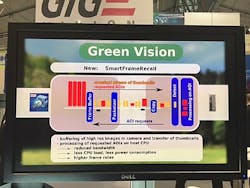Embedded vision, hyperspectral imaging, and multispectral imaging among trends identified at VISION 2016
New technologies and trends at VISION 2016
At the moment I am writing this, it is more than halfway through VISION 2016 and I’ve already met with dozens of vision companies from all over the globe to discuss the latest trends, technologies, and news in the industry.
Throughout the next few weeks I will cover each of these meetings in individual articles, but for now, I will highlight some of the trends and technologies I’ve seen up close and personal.
Embedded vision
Matrix Vision has developed a new image processing tool called SmartFrameRecall, for which I saw a demonstration at their booth. This new feature enables a camera to capture high-resolution images and send them to a small, embedded PC for storage in the frame buffer while sending preview images with reduced resolution. This requires lass bandwidth, as the tool only looks for potential defects or areas of interest in the thumbnails, and can pull up a high-resolution upon request if further analysis is necessary.
The benefit such a tool, of course, is that it can be run with less bandwidth on a smaller embedded PC. Dietmar Unser, Marketing Manager, provided an example of a recent system he saw installed for inspection purposes. In this system, eight industrial cameras were connected to eight separate PCs, with a ninth PC being used for image processing. With SmartFrameRecall (pictured), only one single PC is necessary, which opens up new applications in embedded imaging.
Another company involved in embedded vision that I had the chance to meet with was VectorBlox. The company’s MXP Matrix Processor (demonstration pictured), is a scalable and configurable soft-core processor available for all Altera and Xilinx FPGAs that accelerates applications up to 10,000 times, allowing software to perform like hardware. Since the FPGA bitstream does not depend on the algorithm, MXP enables rapid algorithm development, according to VectorBlox.
Guy Lemieux, CEO, showed us a demonstration of the technology at this booth. In the demo, a face detection application was shown running both with and without its MXP processor. While running, the face detection capability was no doubt exponentially faster. Lemieux explained that his company, as of now, is mainly working with research-based projections in embedded systems, but this type of technology could be useful in a wide variety of embedded applications.
Hyperspectral and multispectral imaging
My first meeting on the first day of VISION was with Sergio Manuel, International Sales Engineer at Photonfocus. His company, he explained, develops hyperspectral imaging cameras mainly for food inspection and remote sensing applications. The company’s MV1 series of cameras, which feature imec hyperspectral sensors (which are based on CMOSIS CMOS image sensors), are reportedly at a lower price point than other hyperspectral solutions. Additionally, he noted that—as a result of the cameras’ weight and size—they can be deployed on drones for various applications.
Martin Hund, President and CTO of Chromasens, explained to me a bit about his company’s multispectral imaging product, the truePIXA multispectral line scan camera, which features 6-12 spectral channels and stays in the 360-960 nm range. A product such as this, he explained, could be used in applications such as counterfeit detection and the reproduction of paintings, for example, where the camera could capture accurate color information even when the painting is curvy or bumpy.
I also had the chance to meet Mikko Kannelsuo, Sales and Marketing Director for Specim, who told me that his company’s Specim FX10 is among the first—if not the first—hyperspectral camera that is designed specifically for industrial machine vision. This camera is capable of capturing 220 bands at up to 330 fps, features a spectral range of 400-1000 nm, and is available in Camera link and soon, GigE Vision.
Pictured: A Specim FX10 brochure at VISION 2016.
Unmanned aerial vehicles
Another topic that has come up from time to mind in my conversations is unmanned aerial vehicles, or “drones.” While I still have a full day’s worth of interviews to go, I’ve already talked to a number of companies that are working with drones. Photonfocus, as previously mentioned, is a company that has that has projects in remote sensing, as does Sony.
Matt Swinney, Senior Marketing Manager, Image Sensing Solutions, Semiconductors and Electronic Solutions at Sony told me his company, as well as his division, have a number of different focus areas.
"We do business with drones now," he said. "It depends on the application, but we are able to work with customers on their specific needs. We are always looking at new technologies to get into."
At Matrix Vision, Réda Drissi Alami, Sales Manager, Benelux, briefly told me about a research and development application involving drones that integrated the company’s cameras in order to identify mines. More on this one to come, but Alami noted that the developers were able to use the cameras due to their small form factor and light weight.
Follow us for live updates from VISION 2016.
Share your vision-related news by contacting James Carroll, Senior Web Editor, Vision Systems Design
To receive news like this in your inbox, click here.
Join our LinkedIn group | Like us on Facebook | Follow us on Twitter
Learn more: search the Vision Systems Design Buyer's Guide for companies, new products, press releases, and videos
About the Author

James Carroll
Former VSD Editor James Carroll joined the team 2013. Carroll covered machine vision and imaging from numerous angles, including application stories, industry news, market updates, and new products. In addition to writing and editing articles, Carroll managed the Innovators Awards program and webcasts.


